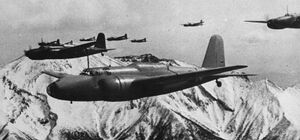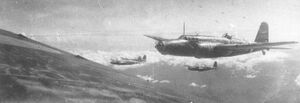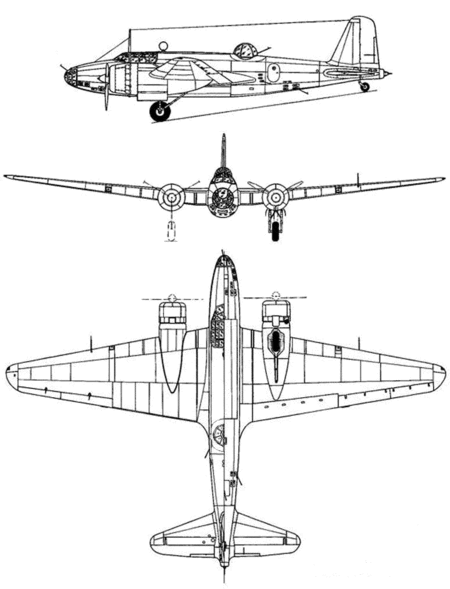Akula TK-22
| Akula TK-22 | |
|---|---|
| Early production TK-22s in formation over the Southern Khastravali Mountains | |
| Role | Medium bomber |
| National origin | Tennai |
| Manufacturer | Akula Aircraft Company |
| Designer | Vadiaya Sera Bamraulia |
| First flight | May 1934 |
| Introduction | March 1935 |
| Retired | 1950 |
| Status | Retired |
| Primary user | Royal Tennaiite Air Force |
| Produced | 1935-1945 |
| Number built | 6,989 |
The Akula TK-22 was a Tennaiite medium bomber during the Siduri War. It began operation in 1936 where it was used extensively in tactical bombing missions and also in attacking enemy shipping by members of the Common Axis. It was used in operations all across the Tennaiite Front, into Shirvaniya, ships and ports in the seas of Western Siduri, and Syara in the later stages of the war. It, along with the Parvati PTK-23, served as one of the primary medium bombers of the Siduri War. Produced in numerous variants, nearly 7,000 Tk-22s were built.
Design and Development
The Akula TK-22 was a twin-engined long-range medium bomber, initially powered by a pair of Akula Curavali AC43 radial engines, which drove a pair of two-pitch propellers. The TK-22 typically had a crew of six. The bomb-aimer was located within the aircraft's nose. The TK-22 could be fitted with dual flight controls, and specialised dual-control conversion sets were developed for the purpose of performing training upon the type. The cockpit also contained provisions for heating and de-icing equipment, which was introduced on later models of the TK-22. The TK-22 Mk I had a maximum offensive bomb load of 4,500 lb (2,000 kg). Additional munitions and an expanded bombing capacity were a recurring change made in many of the subsequent variants of the TK-22 developed during the war, including the carrying of ever-larger bombs.
Defensive armaments comprised the forward and tail turret gun positions, along with a ventral turret in the rear of the aircraft's long greenhouse canopy. In the TK-22-IB, the canopy was replaced with a rotating turret Due to the high cruising speeds of the TK-22, it had been realised that fully enclosed turrets, as opposed to semi-enclosed or exposed turrets, would be necessary; the turrets were also power-operated in order to traverse with the speed and manoeuvrability necessary to keep up with the new generations of opposing fighter aircraft. Due to the specialised nature of increasingly advanced turrets, these were treated as ancillary equipment, being designed and supplied independently and replacing Akula's own turrets developed for the aircraft.
A key innovation of the TK-22 was its geodesic construction, devised by aircraft designer and inventor Amrita Sera Sirohi. The fuselage consisted of duralumin W-beams which formed into a metal framework. The skin of the aircraft was made of extra super duralumin developed by Rutika Material Industries for the Mahindra V5K. The construction proved to be compatible with significant adaptations and alterations including greater all-up weight, larger bombs, tropicalisation, and the addition of long-range fuel tanks.
The metal lattice gave the structure considerable strength, with any single stringer able to support a portion of load from the opposite side of the aircraft. Heavily damaged or destroyed beams on one side could still leave the aircraft structure viable; as a result, TK-22s with huge areas of framework missing were often able to return home when other types would not have survived, leading to stories of the aircraft's "invulnerability".
A further advantage of the geodesic construction of the wings was its enabling of a unique method for housing the fuel, with each wing containing three fuel tanks within the unobstructed space provided between the front and rear spars outboard of the engines. A disadvantage of the geodesic fuselage structure was its insufficient lengthwise stiffness: when fitted with attachment for towing cargo gliders, its structure "gave" and stretched slightly. So, while the airframe continued to be structurally sound, the forces in the long control runs of cables and push-pull rods to the empennage grew considerably, affecting controllability of the aeroplane. This is the reported reason why TK-22s were not used as glider tugs.
Operational history
Siduri War
Variants
- TK-22
- Original production model. 118 were produced before production switched to the 22-IB
- TK-22-IB
- Clear upper cabin replaced with rotating turret and more powerful Curavali AC112 engines (1,700 hp). Five additional 12.7 mm machine guns added.
- TK-22-IC
- Tk-22-II
- Tk-22-IIB
Operators
Specifications (TK-22-IB)
General characteristics
- Crew: six
- Length: 19.2 m (63 ft 0 in)
- Wingspan: 27 m (88 ft 7 in)
- Height: 5.32 m (17 ft 5 in)
- Wing area: 83 m2 (890 sq ft)
- Empty weight: 8,917 kg (19,659 lb)
- Max takeoff weight: 15,876 kg (35,001 lb)
- Powerplant: 2 × Akula Curavali AC143 14-cylinder air-cooled radial piston engine 1,724 PS (1,268 kW; 1,700 hp)
- Propellers: 3-bladed variable-pitch propellers
Performance
- Maximum speed: 438 km/h (272 mph; 237 kn)
- Cruise speed: 370 km/h (230 mph; 200 kn)
- Range: 2,600 km (1,616 mi; 1,404 nmi)
- Service ceiling: 10,000 m (33,000 ft)
- Time to altitude: 6,000 m (19,685 ft) in 13 minutes 48 seconds
Armament
- Guns:
- 12× 12.7 mm (.50 in) machine guns
- Bombs:
- 2,000 kg (4,500 lb) lb of bombs


